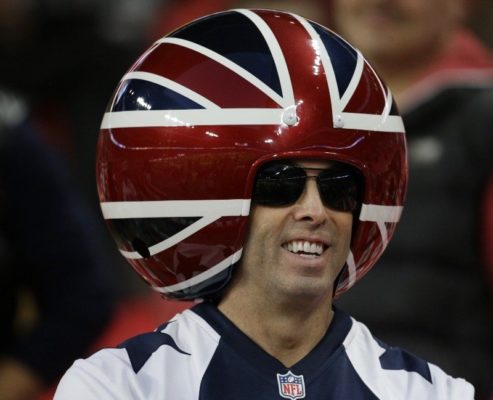American football in Europe may not be forever, but as long as it remains a thing, it’s going to be the thing in London.
As a British fan of American football, there are many elements of the NFL’s annual trips to Wembley that make me proud to be part of the United Kingdom’s football community.
I’ll always be impressed by the patchwork sea of jerseys that represent not only all 32 current teams, but also throwbacks to NFL Europe and the USFL, as well as the U.K.’s countless domestic sides. I don’t think I’ll ever stop chuckling at the confused public reaction to these gaudy jerseys, which seem utterly out of place on the Underground. And it’s still amazing to witness the mass outpouring of unadulterated fandom at the stadium, like an 80,000-strong choir shouting “I am Spartacus” in harmonized unison.
Hyperbole aside, the game-day experience is refreshingly tangible for a marginalized group of sports fans used to keeping anti-social hours. The International Series provides a breath of fresh air for those normally found hunching over laptop screens after midnight to follow a game online, or, if they can’t manage to stay awake, blearily checking box scores the next morning.
Oh, no, they’re everywhere! (AP)
With the International Series now having concluded its seventh year, initial fears that support for American football might stagnate have proven wildly misguided. And even though I am on record as a hardened skeptic of an NFL team in Britain, it’s hard to shake the feeling that this season’s slate was a turning point in the league’s journey towards London.
In fact, the NFL has become a staple of our sporting calendar. In becoming routine, it has also become accepted, England soccer manager Roy Hodgson’s recent grumblings aside. The Football Association and Mayor Boris Johnson’s push for a permanent franchise is testament to this evolution. Their ears have pricked to the sound of pennies dropping, a much-needed influx of money considering the recent difficulties of the national soccer team’s attendance. As those ugly figures make Wembley stadium look increasingly pale and elephantine with each passing year, American football represents a cash-flush antidote to that problem.
This official backing has also created a certain comfort among football fans in the U.K. In the past, it was common to complain about the teams sent here. Now, even as the Jacksonville Jaguars (19–45 since 2010) have taken up semi-permanent residence, fans have praised the advancement and ignored their ability.
None of which completely erased the slight whimper of complaint that was audible during theannouncement of the teams representing the NFL in the 2015 International Series. Half of the teams that played in Wembley this year will visit again next year (Dolphins, Jaguars and Lions), and that repetition didn’t sit too well at first. But this is still England, so any potential patter of complaint is immediately drowned out by a deluge of pleasantries; cautionary nibbles towards the hand that feeds were followed by a kiss of the ring.
Rightfully so, too, because we’re not in a position to complain. We Brits that attended the 12 games held since 2007 have been lucky to witness some remarkable moments. We witnessed the first Drew Brees revenge match, Tom Brady and Wes Welker’s poetry in motion, six separate one-score-games, five blowouts, and—the holy grail—a Tim Tebow rushing score. Not to mention the eventual Super Bowl champion New York Giants’ appearance in 2007.
The 2014 schedule didn’t disappoint, either. Seven friends and I were at Wembley for the Lions and Falcons, when Detroit had two chances to win the game with a field goal at the end of regulation.
None of my buddies had any interest in the sport outside of its basic aesthetic violence, but their own blind spots were soon sublimated by the dazzling action, and after just 60 minutes of play, their understanding and interest in the sport had increased tenfold. If the goal of the International Series is to find new fans, Commissioner Roger Goodell should consider it mission accomplished.
Even using the NFL’s own, and perhaps misleading, metrics regarding its European fan base, it’s clear that the ultimate goal of a permanent British franchise will remain in flux until it can reach a wider audience. The unique “Americanness” of the gameday experience is perhaps the critical ingredient in spreading football fever across the U.K. The cheerleaders, the fan rallies, the player appearances, and, ultimately, the sheer energy of the “match” itself helps turn a corner of North London into Little America. That kind of engagement is vital in reaching those fans looking to embrace a new-to-them sport. (The tailgating really, really helps, too.)
The three games held this year were some of the most compelling watches in the seven-year history of the series. With another trio planned in 2015, the normalization of the NFL won’t lead to a stagnation of support, but instead should provide a foundation for more Wembley gamedays and more wide-eyed converts. The future of the NFL in London is certainly not (yet) guaranteed, but for those of us who have committed to surf football’s wave — whether it crests or not — we’re very much enjoying the ride.

